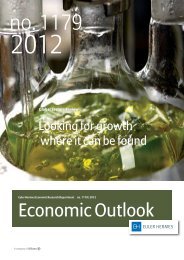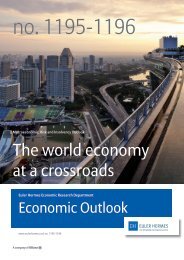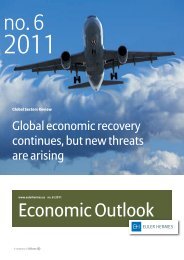<strong>Euler</strong> <strong>Hermes</strong>Economic Outlook n° 1187 | Special Report | The <strong>Re<strong>in</strong>dustrialization</strong> of the United StatesOverviewLike a PhoenixRis<strong>in</strong>g from the AshesA turn<strong>in</strong>g po<strong>in</strong>t?Ever s<strong>in</strong>ce the Industrial Revolution began <strong>in</strong> the1800s, the U.S. manufactur<strong>in</strong>g sector has alwaysbeen of vital economic importance. It has often beenthe eng<strong>in</strong>e of growth, historically provid<strong>in</strong>g strongcontributions to Gross Domestic Product (GDP).Dur<strong>in</strong>g the n<strong>in</strong>eteenth and twentieth centuries economic<strong>in</strong>dustrial concentrations developed across theU.S. In the South, proximity to cotton growers helpedbuild the textile <strong>in</strong>dustry. From the Northeast to thecentral Midwest, steel and iron products emergedand as a result the automobile <strong>in</strong>dustry arose <strong>in</strong> theMidwest. In the Southwest, an abundance of oil andnatural gas shaped the energy <strong>in</strong>dustry. And <strong>in</strong> theWest, high technology emerged dur<strong>in</strong>g and afterWWII as a product of the defense <strong>in</strong>dustry.However this robust manufactur<strong>in</strong>g economy cameunder <strong>in</strong>tense pressures <strong>in</strong> the latter half of thetwentieth century from the development of theglobal economy. Countries such as Japan, Mexicoand Ch<strong>in</strong>a emerged with enormous supplies of peoplewho were will<strong>in</strong>g to work for a fraction of U.S.wages, while concurrently, American consumersdeveloped a thirst for <strong>in</strong>expensive goods from overseas.American bus<strong>in</strong>esses could not resist the lure ofmuch lower manufactur<strong>in</strong>g costs available <strong>in</strong> thesecountries and began to send U.S jobs overseas, decimat<strong>in</strong>gmany <strong>in</strong>dustries such as appliances, furniture,heavy equipment, shipbuild<strong>in</strong>g, steel, textiles, andmany others. As a result of this shift, the U.S. manufactur<strong>in</strong>g<strong>in</strong>dustry shrank drastically as a percentage4
Economic Outlook n° 1187 | Special Report | The <strong>Re<strong>in</strong>dustrialization</strong> of the United States<strong>Euler</strong> <strong>Hermes</strong>of the entire economy and millions of manufactur<strong>in</strong>gjobs were lost.But this trend is now on the cusp of reversal for severalreasons. U.S. manufactur<strong>in</strong>g productivity hasgrown at a relatively high rate compared to other<strong>in</strong>dustrialized nations, mak<strong>in</strong>g U.S. unit labor coststhe lowest <strong>in</strong> the <strong>in</strong>dustrialized world. Highly skilledAmerican workers can more reliably produce highervalue-added goods. Costs such as transportation,<strong>in</strong>ventory and lag time are lower while tax <strong>in</strong>centivesand cheap energy make manufactur<strong>in</strong>g <strong>in</strong> the U.S.even more attractive.As a result, U.S. manufactur<strong>in</strong>g is enjoy<strong>in</strong>g a renaissanceand recently led the country out of the mostsevere recession s<strong>in</strong>ce the Great Depression, contribut<strong>in</strong>gmuch more to GDP growth than one wouldexpect given its weight <strong>in</strong> the economy. In fact, afterthe recession, the only job growth outside the servicessector was <strong>in</strong> manufactur<strong>in</strong>g. Of course theoutlook is brighter for some <strong>in</strong>dustries and regionsthan it is for others, but the bus<strong>in</strong>ess environmentsuggests that conditions go<strong>in</strong>g forward will cont<strong>in</strong>ueto be favorable, even <strong>in</strong> a world of uncerta<strong>in</strong>ty.Short-lived effect or durable trends?Beyond positive macroeconomic factors such ascredit availability and low <strong>in</strong>terest rates, the threedeterm<strong>in</strong>ants of this re<strong>in</strong>dustrialization are:• lower labor costs, especially <strong>in</strong> the southernstates;• lower cost of energy result<strong>in</strong>g from the shalegas bonanza; and• the ability to steer the economic environmentto leverage the positive cost reductions fromwhich companies have been benefitt<strong>in</strong>g.Another factor is the new awareness of operat<strong>in</strong>gvulnerability created by an over-stretched supplycha<strong>in</strong>. In 2011, the localized production disruptions<strong>in</strong> Japan follow<strong>in</strong>g an earthquake and a tsunami, and<strong>in</strong> Thailand from flood<strong>in</strong>g, disrupted <strong>in</strong>dustrial operationsall around the world. The <strong>in</strong>cidents highlightedhow dangerous exposure to foreign supply cha<strong>in</strong>scould be and how a lack of preparedness for theserisks causes difficulty <strong>in</strong> implement<strong>in</strong>g risk managementprotocols for what were previously thought tobe unth<strong>in</strong>kable events.Go<strong>in</strong>g forward, and when exam<strong>in</strong><strong>in</strong>g specific U.S.<strong>in</strong>dustry dynamics, it seems important to selectivelysupport:• The “sh<strong>in</strong><strong>in</strong>g” <strong>in</strong>dustries mentioned above, <strong>in</strong>order to identify more specifically the grow<strong>in</strong>gsubsectors (agriculture, construction/m<strong>in</strong><strong>in</strong>g,mach<strong>in</strong>ery, medical equipment, petroleum-relatedproducts, semiconductor-related products)and exam<strong>in</strong>e their dynamics. The automotive sectoralso seems to be reviv<strong>in</strong>g from its ashes;• A conducive bus<strong>in</strong>ess climate with a clear emphasison <strong>in</strong>novation. The new era <strong>in</strong> the bus<strong>in</strong>essenvironment (tighten<strong>in</strong>g gap between Ch<strong>in</strong>eseand American wages, appreciation of the yuan,access to cheap energy <strong>in</strong> the U.S., structural highoil prices, mount<strong>in</strong>g awareness of the vulnerabilitycaused by an over-stretched supply cha<strong>in</strong>) couldhelp U.S. manufactur<strong>in</strong>g susta<strong>in</strong> this momentum.U.S. computer/electronic product manufactur<strong>in</strong>g,mach<strong>in</strong>ery, furniture and miscellaneous productmanufactur<strong>in</strong>g are expected to take advantageof the fall<strong>in</strong>g Ch<strong>in</strong>ese wage competitiveness.Chemicals and primary metal sectors should ga<strong>in</strong>ground thanks to cheap shale gas; and• Regional strengths make the efficient specializationof the <strong>in</strong>dividual states feasible. The dynamics<strong>in</strong> the South, Texas, and California - particularlywith niche sectors, <strong>in</strong>centives, and opportunities- are particularly important as they appear to bethe renewed growth centers of the U.S.This degree of <strong>in</strong>dustrial <strong>in</strong>vestment demands thatthe U.S. economy present sound, reliable growthprospects and that the f<strong>in</strong>ancial system (banks andbond markets) support these capital <strong>in</strong>tensive projects.It also requires a confidence <strong>in</strong>jection for theprivate sector to cont<strong>in</strong>ue to re-shore and <strong>in</strong>vest <strong>in</strong>the economy. F<strong>in</strong>ally, the path to <strong>in</strong>dustrial rebirth willrequire a highly skilled workforce. ©5












